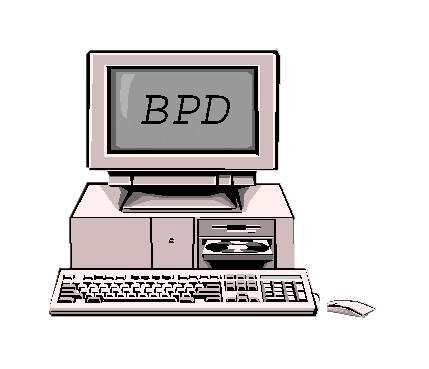|

|
| Computer Graphic Courtesy of Steve Marson |
The Committee on Information Technology and Distance Education was founded at the 1990 APM by charter members, Steve Marson,
Bob Vernon, Chet Dilday, and Dennis Cogswell, and was originally called the Committee on Information Technology and Social
Work Education (CIFTSWE). The Committee’s first workshop was held at the 1992 BPD Conference in San Antonio. Steve
brought a hard drive to the session and opened it with a screwdriver to show participants how it worked, thus attempting to
demystify the machine.
The Committee’s first hands on workshop was held in 1993 at the University of Maryland This workshop was presented by
Harry Chaiklin, Dennis Cogswell, Bob Vernon, and Steve Marson, and “the philosophy was ‘hands-on, informal, and
inexpensive’”. (Finn, 1998).
Subsequent workshops over the next several years focused on introducing new users to the computer and the emerging internet.
Participants traveled by bus to local universities in the BPD Conference’s host city to participate in hands-on laboratory
sessions. The bus trips themselves often became adventures. While on route and during travel delays, we were led in choruses
of the Internet Song by Steve Marson. The early sessions included:
• Learning to establish an email account using free/cheap email services
• Practice in sending and receiving email messages,
• Subscribing to, sending, and receiving messages from Listservs,
• Working with Usenet, and
• Doing “simple” searches with Archie, Veronica, and gopher (the not-so-user-friendly precursors of the
search engines we use today)
.
Early workshops offered training in use of both the MAC and the PC, with Chet Dilday serving as resident MAC expert. Chet
also maintained an internet camera in his computer lab which sent live video online years before this became commonplace.
He demonstrated this at workshops to the amazement of participants.
In 1992, Marshall Smith made “a very eloquent, short, but powerfully moving speech [in which he] expressed the importance
of the Internet for the accreditation process. He made a plea that board members consider accepting self-studies via the
Internet. Marshall was ahead of his time...” (Marson, 1997) His vision became a reality ten years later when Rhode
Island College became the first school to submit its self study electronically.
In 1994, Steve and Marshall developed a film entitled Cheap Email: The Movie to be shown at that year’s BPD Conference.
It had a companion volume, Cheap Email: The Paper. Steve Marson (a/k/a Robert Redford) could not attend the conference as
he was at home witnessing the birth of his daughter. Technology was used to allow him to participate electronically in that
conference.
In 1995 the BPD listserv and BPD web page were established by Marshall Smith at RIT. Marshall managed the listserv for BPD
from then until it was transferred to Bob Vernon at IUPUI in 2002. The web site and the listserv are two wonderful resources
that have helped to bring BPD into the age of technology. Equally important is the listserv’s role in facilitating
information exchange and ongoing networking among BPD’s geographically dispersed 800+ members. At the time of this
writing, the BPD website is being transferred from Marshall Smith to Bob Vernon, the new web weaver. If you haven’t
visited the new web site, please go to: www.bpdonline.org or http://bpdonline.org. (If you get the old site, you will have
to erase any old bookmark or favorites listing you have for the web site and set up a new favorite/bookmark listing.)
Also in 1995, BPDers Wanda Bracy and Esther Langston established the first “disk service”. BPD presenters were
encouraged to share their conference papers as computer files. The files were copied onto disks and the set of disks were
sold at the conference. (Finn, 1998). This service, like many other early efforts, had to contend with files in both PC
and MAC format, documents prepared in a variety of different software programs, and the presence of viruses in some of the
files.
The Committee on Information Technology and Distance Education became an official standing committee of BPD (with the added
charge of distance education) at the 1995 APM.
Chairpersons on the Committee have been:
• Steve Marson (1992 - 1996)
• Marshall Smith (1996 - 1998)
• Lynn Adkins (1998 – Present)
“Later workshops introduced cutting-edge (some like to say ‘bleeding edge’) technology and software...”
(Finn, 1998) In the late 1990’s the Committee began to change the focus of its work to meet new demands created by
burgeoning technology and heightened technological skills of BPD members. To better gauge the level for future technology
workshops, the Committee decided to conduct a survey of BSW programs. The only barrier was paying for postage to mail the
surveys. Thanks to the efforts of Committee member Lisa Gebo, postage for the survey was underwritten by Brooks Cole. Bob
Vernon then completed the survey and analyzed the data. From the survey findings, the Committee learned that almost all BSW
programs had access to email and the internet. It was now time to develop more sophisticated workshops to meet newly developing
needs of a rapidly growing group of technologically literate social work educators. The Committee began developing workshops
on topics such as:
• Electronic Toolbox Programs
• Use of technology in teaching
• Online practice and ethics
• The Y2K bug
|
